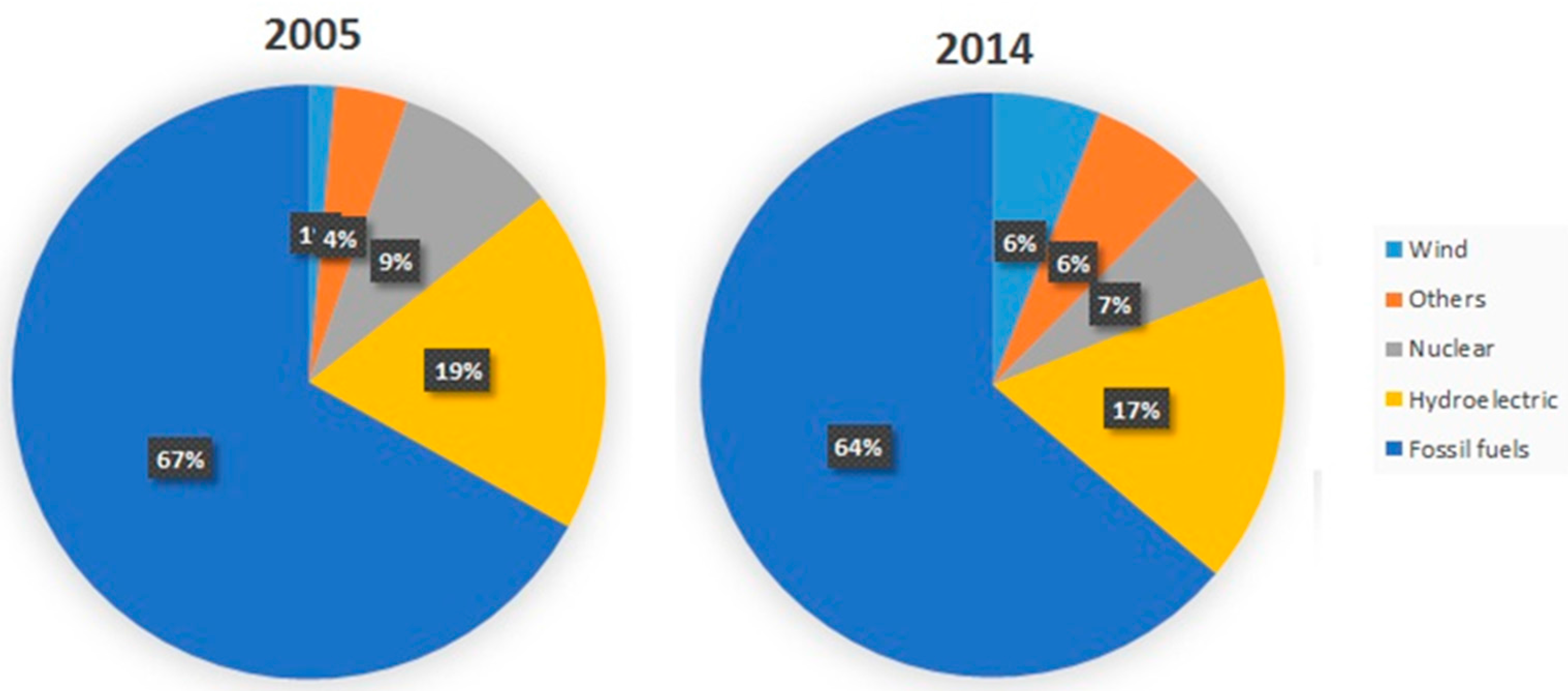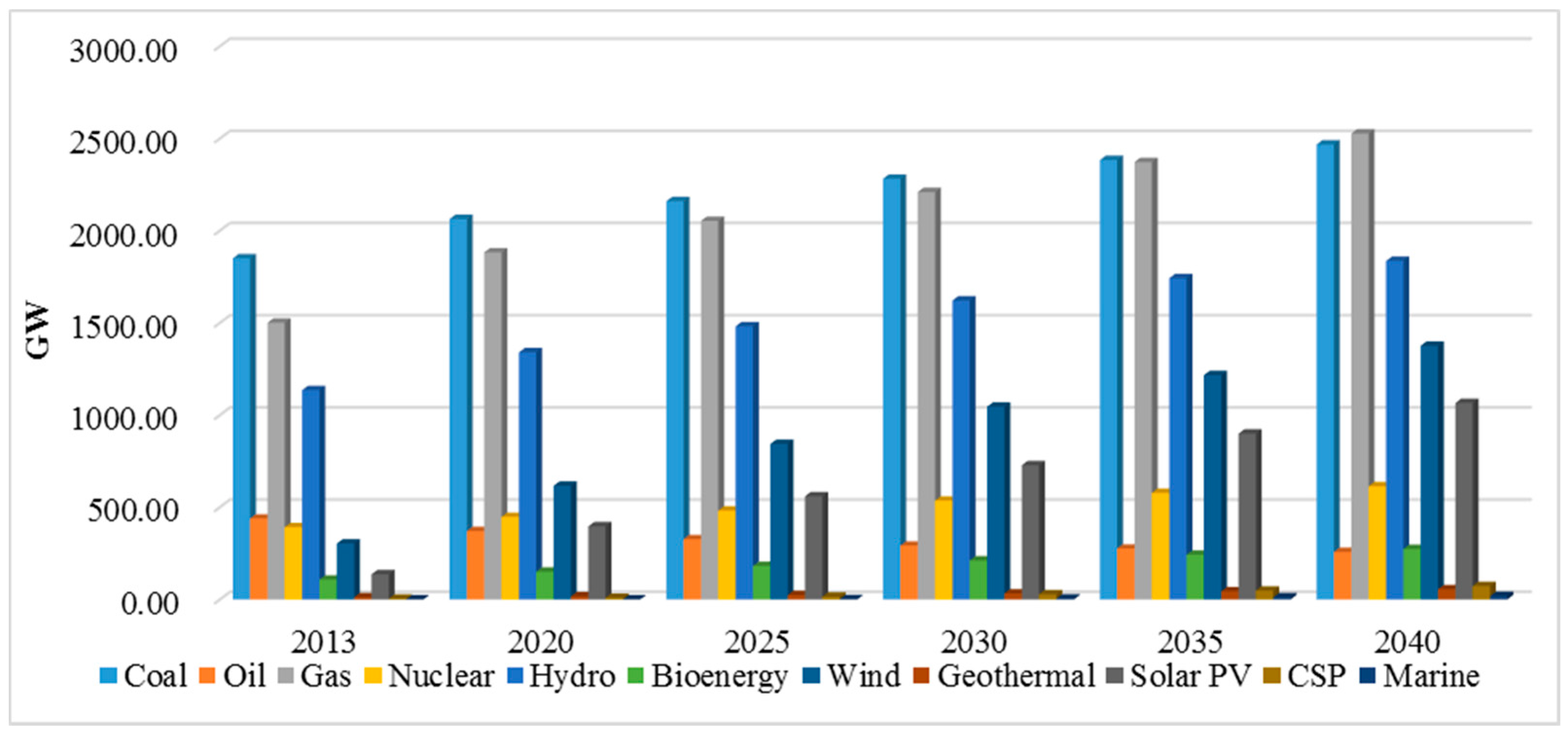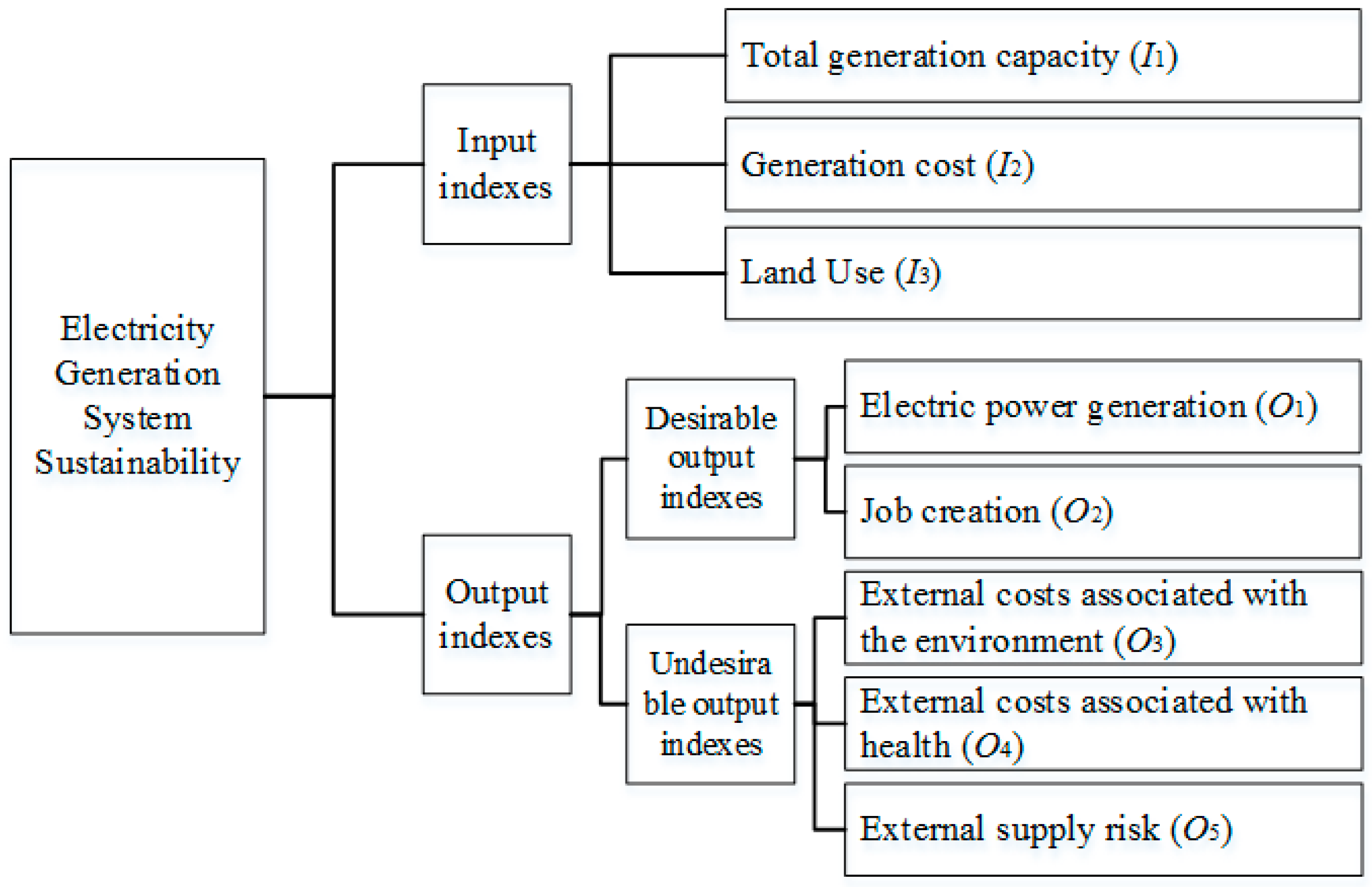A Comparison of Electricity Generation System Sustainability among G20 Countries
Abstract
:1. Introduction
2. Literature Review
3. Electricity Generation Status and Future
4. The Evaluation Indexes and Model
4.1. The Evaluation Indexes of Electricity Generation System Sustainability
4.2. Analysis Method
4.2.1. Analysis Process
4.2.2. The Super-Efficiency DEA (SE-DEA) Model
4.2.3. Spearman’s Correlation Test
5. The Sustainability of the Electricity Generation Systems of 23 Countries
5.1. Data Collection
5.2. Parameter Collection
5.3. Descriptions of Indexes’ Values
5.4. Sustainability of Electricity Generation System
5.5. Influencing Factors Analysis
6. Conclusions
Acknowledgments
Author Contributions
Conflicts of Interest
References
- China General Office of the State Council. Energy Development Strategy Action Plan (2014–2020); China General Office of the State Council: Beijing, China, 2014.
- U.S. Energy Information Administration. Annual Energy Outlook 2012 Early Release; EIA: Washington, DC, USA, 2012.
- International Energy Agency. Energy Climate and Change; IEA: Paris, France, 2015. [Google Scholar]
- World Commission on Environment and Development. Our Common Future; Oxford University Press: Oxford, UK, 1987. [Google Scholar]
- Karger, C.R.; Hennings, W. Sustainability evaluation of decentralized electricity generation. Renew. Sustain. Energy Rev. 2009, 13, 583–593. [Google Scholar] [CrossRef]
- Wang, L.; Xu, L.; Song, H. Environmental performance evaluation of Beijing’s energy use planning. Energy Policy 2011, 39, 3483–3495. [Google Scholar] [CrossRef]
- Rahman, M.M.; Paatero, J.V.; Lahdelma, R. Evaluation of choices for sustainable rural electrification in developing countries: A multi criteria approach. Energy Policy 2013, 59, 589–599. [Google Scholar] [CrossRef]
- Yang, Q.; Chen, G.Q.; Liao, S.; Zhao, Y.H.; Peng, H.W.; Chen, H.P. Environmental sustainability of wind power: An emergy analysis of a Chinese windfarm. Renew. Sustain. Energy Rev. 2013, 25, 229–239. [Google Scholar] [CrossRef]
- Phillips, J. Determining the sustainability of large-scale photovoltaic solar power plants. Renew. Sustain. Energy Rev. 2013, 27, 435–444. [Google Scholar] [CrossRef]
- Kurka, T. Application of the analytic hierarchy process to evaluate the regional sustainability of bioenergy developments. Energy 2013, 62, 393–402. [Google Scholar] [CrossRef]
- Verbruggen, A.; Laes, E.; Lemmens, S. Assessment of the actual sustainability of nuclear fission power. Renew. Sustain. Energy Rev. 2014, 32, 16–28. [Google Scholar] [CrossRef]
- Bi, G.-B.; Song, W.; Zhou, P.; Liang, L. Does environmental regulation affect energy efficiency in China’s thermal power generation? Empirical evidence from a slacks-based DEA model. Energy Policy 2014, 66, 537–546. [Google Scholar] [CrossRef]
- Al Garni, H.; Kassem, A.; Awasthi, A.; Komljenovic, D.; Al-Haddad, K. A multicriteria decision making approach for evaluating renewable power generation sources in Saudi Arabia. Sustain. Energy Technol. Assess. 2016, 16, 137–150. [Google Scholar] [CrossRef]
- Streimikiene, D.; Sliogeriene, J.; Turskis, Z. Multi-criteria analysis of electricity generation technologies in Lithuania. Renew. Energy 2016, 85, 148–156. [Google Scholar] [CrossRef]
- Grilli, G.; De Meo, I.; Garegnani, G.; Paletto, A. A multi-criteria framework to assess the sustainability of renewable energy development in the Alps. J. Environ. Plan. Manag. 2016, 10, 1–20. [Google Scholar] [CrossRef]
- Saaty, T.L. Decision making with the analytic hierarchy process. Int. J. Serv. Sci. 2008, 1, 83–98. [Google Scholar] [CrossRef]
- Charnes, A.; Cooper, W.W.; Rhodes, E. Measuring the efficiency of decision making units. Eur. J. Oper. Res. 1978, 2, 429–444. [Google Scholar] [CrossRef]
- Berg, S. Water Utility Benchmarking: Measurement, Methodologies, and Performance Incentives; International Water Association: London, UK, 2010. [Google Scholar]
- International Energy Agency. World Energy Outlook 2015; IEA: Paris, France, 2015. [Google Scholar]
- Li, J.; Li, J.; Zheng, F. Unified Efficiency Measurement of Electric Power Supply Companies in China. Sustainability 2014, 6, 779–793. [Google Scholar] [CrossRef]
- Puth, M.-T.; Neuhauser, M.; Ruxton, G.D. Effective use of Spearman’s and Kendall’s correlation coefficients for association between two measured traits. Anim. Behav. 2015, 105, 77–84. [Google Scholar] [CrossRef]
- Maxim, A. Sustainability assessment of electricity generation technologies using weighted multi-criteria decision analysis. Energy Policy 2014, 65, 284–297. [Google Scholar] [CrossRef]
- Alyssa, K.; Karl, G. Promoting Geothermal Energy: Air Emissions Comparison and Externality Analysis. Electr. J. 2005, 18, 90–99. [Google Scholar]






| Authors | Evaluation Object | Indexes | Method |
|---|---|---|---|
| Cornelia R. Karger, Wilfried, Hennings [5] | Decentralized electricity generation | Environmental protection | Analytic Hierarchy Process |
| Health protection | |||
| Security of supply | |||
| Economic aspects | |||
| Social aspects | |||
| Lei Wang, Linyu Xu, Huimin Song [6] | Energy system | Structure of energy use | Analytical Hierarchy Process |
| Technical and efficiency | |||
| Environmental impacts | |||
| Socio-economic benefits | |||
| Md. Mizanur Rahman, Jukka V. Paatero, Risto Lahdelma [7] | Rural electrification | Technical dimension | Multi-criteria approach |
| Economic dimension | |||
| Social dimension | |||
| Environmental dimension | |||
| Policy/regulation dimension | |||
| Q. Yang, G.Q. Chen, S. Liao et al. [8] | Wind Power | Percent renewable | Mathematical model |
| Energy yield ratio | |||
| Environmental loading ratio | |||
| Energy investment ratio | |||
| Energy sustainability index | |||
| Jason Phillips [9] | Photovoltaic solar power plants | Human health and well-being | Mathematical model |
| Wildlife and habitat | |||
| Land use and geohydrological resources | |||
| Climate change | |||
| Thomas Kurka [10] | Bioenergy | GHG Emissions | Analytic Hierarchy Process |
| Air Quality | |||
| Waste | |||
| Economic Viability | |||
| Regional Energy Self-Sufficiency | |||
| Efficiency | |||
| Technology | |||
| Regional Job Creation | |||
| Regional Food Security | |||
| Aviel Verbruggen, Erik Laes, Sanne Lemmens [11] | Nuclear fission power | Environmental/ecological | Empirical analysis |
| Economics | |||
| Risks | |||
| Social | |||
| Governance/policy | |||
| G.-B. Bi, W. Song, P. Zhang, L. Liang [12] | Thermal power generation | Installed capacity | Data envelopment analysis |
| Labor | |||
| Coal total | |||
| Gas total | |||
| Power Generated | |||
| SO2 | |||
| NOx | |||
| Soot | |||
| Hassan Al Garni, Abdulrahman Kassem, Anjali Awasthi et al. [13] | Renewable power generation | Technical | Analytic Hierarchy Process |
| Environmental | |||
| Socio-political | |||
| Economic | |||
| Dalia Streimikien, Jurate Sliogeriene, Zenonas Turskis [14] | Electricity generation technologies | Institutional political criteria | Analytic Hierarchy Process |
| Economic Criteria | |||
| Social-ethics criteria | |||
| Technological criteria | |||
| Environmental protection criteria | |||
| Gianluca Grilli, Isabella De Meo, Giulia Garegnani, Alessandro Paletto [15] | Renewable energy | Environmental impacts | Multi-criteria analysis |
| Social impacts | |||
| Economic impacts |
| Variable | Unit | No. | Mean | StDev | Min | Max | |
|---|---|---|---|---|---|---|---|
| Installed Capacity | NC | GW | 230 | 14.444 | 23.956 | 0.000 | 101.885 |
| HC | GW | 230 | 29.114 | 44.430 | 0.000 | 249.000 | |
| SC | GW | 230 | 1.960 | 5.158 | 0.000 | 32.771 | |
| WC | GW | 230 | 6.977 | 13.391 | 0.000 | 88.380 | |
| FC | GW | 230 | 113.214 | 196.844 | 0.477 | 823.900 | |
| GC | GW | 230 | 0.257 | 0.561 | 0.000 | 2.592 | |
| Net Generation | NUG | TWh | 230 | 97.774 | 176.833 | 0.000 | 806.968 |
| HG | TWh | 230 | 106.653 | 167.666 | 0.000 | 1029.300 | |
| SG | TWh | 230 | 2.108 | 5.275 | 0.000 | 33.880 | |
| WG | TWh | 230 | 13.665 | 28.113 | 0.000 | 182.090 | |
| FG | TWh | 230 | 468.407 | 801.357 | 0.764 | 3697.000 | |
| GG | TWh | 230 | 1.544 | 3.470 | 0.000 | 15.562 | |
| BG | TWh | 230 | 11.222 | 16.798 | 0.000 | 78.970 |
| Parameter | Unit | Type | Nu | H | S | W | F | G | B |
|---|---|---|---|---|---|---|---|---|---|
| LCOE | $/MWh | 5% | 53.79 | 26.35 | 177.80 | 76.28 | 64.37 | 39.98 | 72.00 |
| $/MWh | 10% | 87.29 | 46.66 | 301.89 | 109.61 | 79.36 | 68.45 | 97.00 | |
| LU | m2/MWh | 0.12 | 4.10 | 0.46 | 1.57 | 0.39 | 0.74 | 12.65 | |
| ECAWE | €c/MWh | Min | 0.04 | 0.01 | 0.16 | 0.02 | 0.98 | 0.01 | 0.03 |
| Max | 0.13 | 0.33 | 0.16 | 0.08 | 7.35 | 0.33 | 0.75 | ||
| ECAWH | €c/MWh | Min | 0.16 | 0.02 | 0.44 | 0.03 | 1.02 | 0.02 | 0.17 |
| Max | 0.57 | 0.67 | 0.44 | 0.17 | 7.65 | 0.67 | 4.25 | ||
| JC | Job years/GWh | 0.14 | 0.55 | 0.23 | 0.17 | 0.11 | 0.25 | 0.21 | |
| ESR | Score/TWh | 1.80 | 0.00 | 0.00 | 0.00 | 5.70 | 0.00 | 0.00 |
| Variable | Unit | No. | Mean | StDev | Min | Max |
|---|---|---|---|---|---|---|
| I1 | GW | 230 | 172.79 | 264.07 | 19.09 | 1223.37 |
| I2 | Billion $ | 230 | 40.51 | 63.14 | 2.23 | 288.69 |
| I3 | km2 | 230 | 797.21 | 1097.63 | 64.57 | 6466.94 |
| O1 | TWh | 230 | 700.69 | 1063.92 | 55.41 | 5060.70 |
| O2 | Job years | 230 | 129,422.97 | 183,657.65 | 11,194.43 | 1,028,172.23 |
| O3 | Billion € | 230 | 35.01 | 59.51 | 0.22 | 275.76 |
| O4 | Billion € | 230 | 37.63 | 63.17 | 0.50 | 292.62 |
| O5 | Score | 230 | 2845.91 | 4757.03 | 45.60 | 21,307.94 |
| Country | Rank | Mean | StDev | Min | Max | Country | Rank | Mean | StDev | Min | Max |
|---|---|---|---|---|---|---|---|---|---|---|---|
| Argentina | 14 | 0.888 | 0.010 | 0.878 | 0.911 | Mexico | 13 | 0.890 | 0.010 | 0.876 | 0.908 |
| Australia | 18 | 0.849 | 0.016 | 0.827 | 0.871 | Netherlands | 22 | 0.799 | 0.024 | 0.766 | 0.828 |
| Brazil | 5 | 0.990 | 0.044 | 0.904 | 1.073 | Russia | 9 | 0.912 | 0.003 | 0.909 | 0.917 |
| Canada | 3 | 0.997 | 0.008 | 0.986 | 1.011 | Saudi Arabia | 8 | 0.924 | 0.000 | 0.924 | 0.925 |
| China | 15 | 0.884 | 0.013 | 0.870 | 0.912 | South Africa | 7 | 0.954 | 0.014 | 0.938 | 0.990 |
| France | 1 | 1.018 | 0.034 | 0.989 | 1.091 | Spain | 20 | 0.815 | 0.037 | 0.766 | 0.862 |
| Germany | 23 | 0.795 | 0.066 | 0.714 | 0.888 | Sweden | 6 | 0.979 | 0.059 | 0.915 | 1.092 |
| India | 11 | 0.893 | 0.020 | 0.868 | 0.920 | Switzerland | 2 | 1.010 | 0.032 | 0.979 | 1.085 |
| Indonesia | 10 | 0.896 | 0.014 | 0.876 | 0.917 | Turkey | 12 | 0.893 | 0.014 | 0.861 | 0.909 |
| Italy | 21 | 0.799 | 0.056 | 0.707 | 0.846 | United Kingdom | 19 | 0.839 | 0.035 | 0.778 | 0.886 |
| Japan | 17 | 0.855 | 0.033 | 0.797 | 0.884 | United States | 16 | 0.869 | 0.008 | 0.855 | 0.879 |
| South Korea | 4 | 0.991 | 0.023 | 0.963 | 1.039 |
| NC | HC | SC | WC | FC | GC | |
|---|---|---|---|---|---|---|
| Correlation | 0.348 ** | 0.431 ** | −0.427 ** | −0.535 ** | −0.331 ** | −0.276 ** |
| Sig. (Two side) | 0.000 | 0.000 | 0.000 | 0.000 | 0.000 | 0.000 |
| No. | 230 | 230 | 230 | 230 | 230 | 230 |
© 2016 by the authors; licensee MDPI, Basel, Switzerland. This article is an open access article distributed under the terms and conditions of the Creative Commons Attribution (CC-BY) license (http://creativecommons.org/licenses/by/4.0/).
Share and Cite
Li, J.; Geng, X.; Li, J. A Comparison of Electricity Generation System Sustainability among G20 Countries. Sustainability 2016, 8, 1276. https://doi.org/10.3390/su8121276
Li J, Geng X, Li J. A Comparison of Electricity Generation System Sustainability among G20 Countries. Sustainability. 2016; 8(12):1276. https://doi.org/10.3390/su8121276
Chicago/Turabian StyleLi, Jinchao, Xian Geng, and Jinying Li. 2016. "A Comparison of Electricity Generation System Sustainability among G20 Countries" Sustainability 8, no. 12: 1276. https://doi.org/10.3390/su8121276





